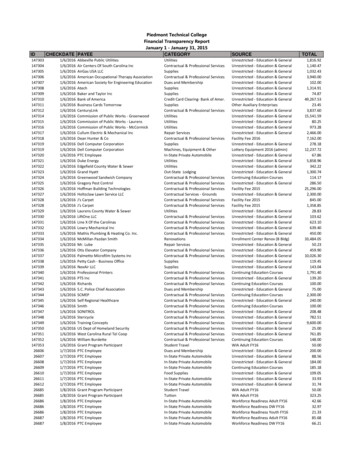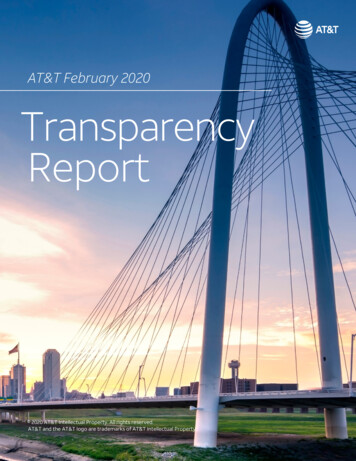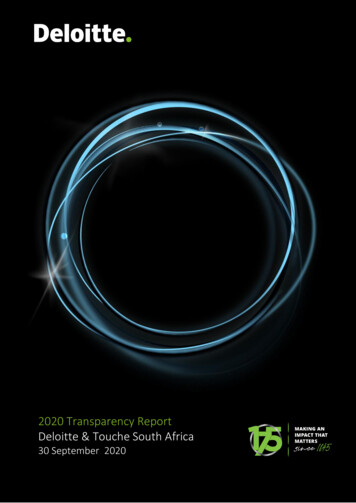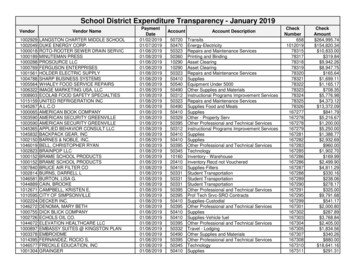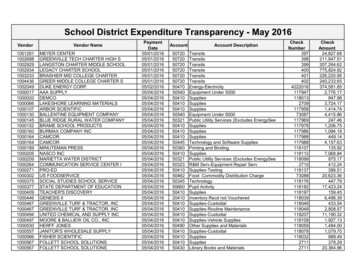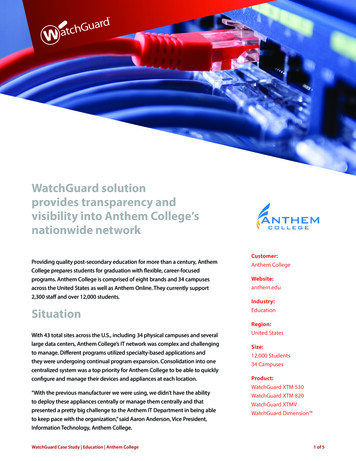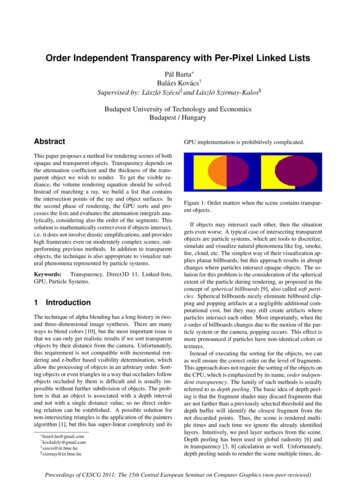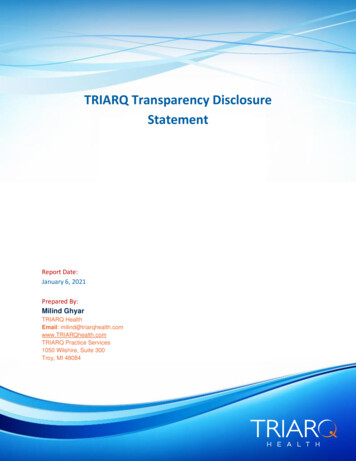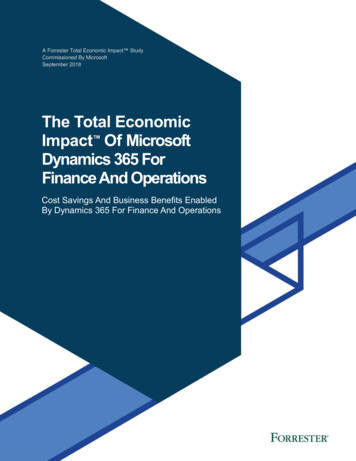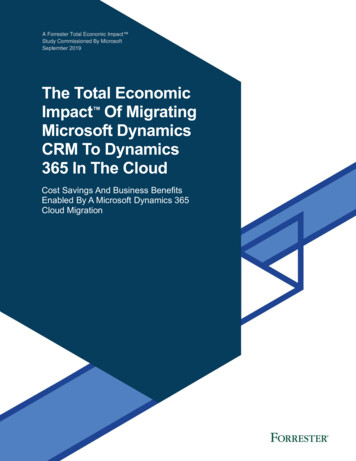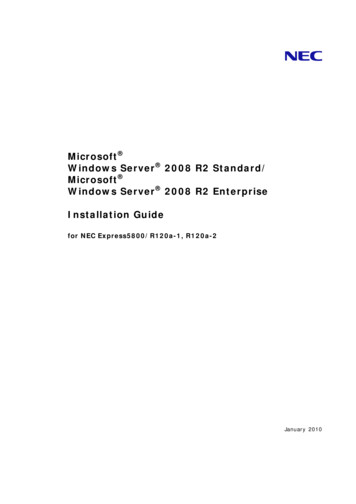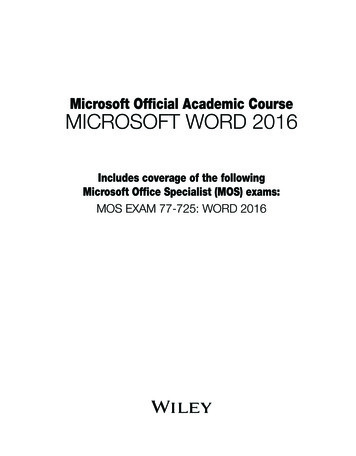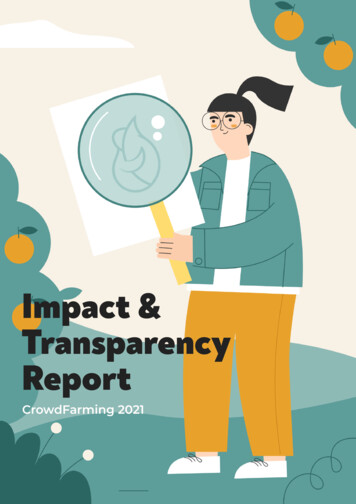
Transcription
Impact &TransparencyReportCrowdFarming 2021
Table ofContentsWhy We Do What We DoHow it all started . 3Defining What Matters Beyond Profit . 4Environmental ImpactOrganic, Biodynamic and Regenerative Farming . 5Food-Waste . 7Plastics Usage . 9Water Usage . 10CO₂ Emissions . 11Internal Environmental Impact and Policies . 14Economic ImpactFair Revenues for Farmers. 15Financial Security Season After Season . 16Social ImpactEmployment . 17An agri-Social Revolution in the Making . 18Our Business in NumbersEconomic Transparency . 20Operational Numbers . 21Our Team . 23A Closing Word for the Future. 24Sources . 252
How it all startedWhen we pioneered the CrowdFarmingidea as young farmers ourselves, wedreamed of radically transforming therelationship between producers andconsumers. We wanted to make it moredirect, more transparent, and moreefficient. We developed, tested andimplemented this model at our ownfamily orchard.“Agriculture allows you to learn thebasics very quickly so you feel usefulright away. However, it will take alifetime of experience to start tounderstand it.“Why We DoWhat We DoAfter 5 years in farming, we discoveredthat by offering our orange trees up foradoption, we could connect in a verypersonal way with families across Europe.These families quickly became engagedin the whole cultivation process, fromseed plantation to consumption. Readingtheir feedback delivery after delivery onlystrengthened our love for agriculture.- Gonzalo ÚrculoThis win-win-winner model (good forproducers, good for consumers, and goodfor the environment!) allowed us to makeour agricultural venture economicallysustainable. We started to gain certainlocal recognition because the directsale to end-consumers was somethingcompletely new in our region. Otherfarmer friends started to ask us whetherwe could set up a website for them,because they also wanted to launch theirown direct-sale channel. At the same time,a growing number of consumers startedto enquire whether we knew producersof other fruits selling just like us.3
Defining What MattersBeyond Profit“We firmly believe that social andenvironmental matters must beconsidered to fully account for thegood a company generates in society.We reject the idea that one’scontribution can only be measuredin pure economic terms.“Needless to say, we saw the possibility toreplicate the idea with any other farmerby using our technology and expertiseto continue creating a positive social andenvironmental impact beyond the fieldsof Valencia: the CrowdFarming agri-socialrevolution started!As Farmers, we have seen the benefits ofdirect-sale: we went from a loss-makingfarm with only 2 employees and on theverge of being abandoned, to a farm fullof life that employs over 40 people.Economically, the direct-sale to endconsumers empowers Farmers byallowing them to have more control overthe sale of their products. Being able toreceive a better price for their produce is,according to an internal survey we did inAugust 2020 between our Farmers, one ofthe most important reasons why Farmerschoose to sell directly to end-consumers.However, and put in simple words, we feelit is unfair the economic angle prevails oversocial and environmental issues. This iswhy we have decided to start quantifyingthe impact CrowdFarming generatesbeyond a number that accountants liketo call “profit”.In this first phase of our Impactand Transparency Report, we haveidentified 3 key areas to start measuringCrowdFarming’s contribution to society:Social Impact, Environmental Impact,and Economic Impact beyond profit.Let’s bring together whatmatters most upfront !Gonzalo ÚrculoFarmeneur4
EnvironmentalImpactOne of the key drivers behind CrowdFarming is promoting sustainable and responsible farming practices. Before wecontinue, we will clarify what we understand by “sustainable” and “responsible”.These are words we hear a lot lately, andtheir meaning may be different to you.“Sustainable” means that the impact ofthe agricultural activities carried-out byfarmers on the land, the flora, fauna, andwater resources can be self-restored. Inother words, the rate of depletion of resources is slower than their natural rateof creation.Organic, Biodynamic,and Regenerative FarmingHow can we promote more sustainablefarming practices?We are proud to support Farmers thatwork hard to build through organic agriculture a more sustainable alternative toexisting food supply-chains. We currentlysupport over 90 organic farming projectsat CrowdFarming. Indeed, more than46% of our Farmers’ projects follow organic-certified farming standards. Doesthat mean the rest of our projects are notsustainable? No.A “responsible” activity is linked to thehuman side of a business. We understand that the wellbeing of workers shouldbe above that of our shareholders: creating quality jobs, partnering with providers that care about their employees, orselling at fair prices are all variables thatshape responsible activities.A CrowdFarming shareholder understands that profit is not a goal, but a consequence of sustainable and responsibleactions.5
It is always a pleasure to welcome organicFarmers into our network, but nothingcompares to helping an ordinary producertransition to organic. We understandorganic agriculture has its own specificrisks. The CrowdFarming model helpsproducers reduce economic uncertaintyby providing a guaranteed price seasonafter season: in fact, producers knowexactly how much they will be paid byend-consumers months ahead of thebeginning of the season. Thanks to thislayer of economic reassurance, manyof our Farmers can commit themselvesto a long-term conversion project thatwould not have been possible in normalcircumstances.projects without intermediaries. Additionally, we are working to help our Farmersin transitioning 4 additional projects tobiodynamic standards.Regenerative agriculture is also part ofour vision to create a more sustainablefuture and a number of our Farmers arealready working following its principles.The key aspects of regenerative agriculture can be summarised as follows:Principles of regenerativeagricultureToday, we are helping our Farmers intransitioning 39 agricultural projectsto organic-certified agriculture, whichmeans that over 66% of our projectsare already organic or in transition toorganic.Some of our Farmers have also taken aslightly different approach to sustainablefarming with biodynamic agriculture,which is a type of agriculture that sharesthe foundations of organic farming. Unlike organic farming however, biodynamicfarming is organised around the lunarcalendar, and the fertilisation is complemented with biodynamic preparations. We are glad to help Farmers reachend-consumers through 9 biodynamic6
Our Farmer-Hunting team provides dailyassistance to these producers, and alsomakes sure all information is accurateand clear so final consumers enjoy anunmatched level of transparency whenbrowsing crowdfarming.com.Food-WasteHow can we reduce food-waste inagriculture and beyond?Before we start finding solutions to thefood-waste problem, it is key to accuratelydefine what we are fighting against.It is worth pointing out the differencebetween food loss, food waste, and foodwastage: Food loss: Food that will neverreach end-consumers despite beingharvested. Example: romaine lettuceleaves that are lost because the retaileronly sells romaine lettuce hearts. Food waste: Food that gets to theend of its life but that was fit forconsumption at some point. Example:expired food at the very rear of yourfridge. Food wastage: In plain words, the sumof food-loss and food-waste.What by definition should be called“food wastage” is often referred to as“food waste” in the media and otherpublications.For simplification purposes, we havedecided to use the term “food waste” torepresent all types of waste.30% of all food waste in the EU occursduring the production and foodprocessing stages, and an additional 5%occurs during the retail and wholesalephases of the food supply-chain accordingto European Parliament Data1. Thanks toadoptions, we are making sure that onlythe food that is going to be consumedis produced. This food is of course soldwithout intermediaries, and therefore noretailer is needed! This means our modelhas the potential to eliminate up to 35%of the food-waste generated in Europeanfood supply-chains. In fact, adoptingmeans that the consumer is paying inadvance for a certain amount of producethe Farmer is going to grow, make, orharvest on-demand for them.1 Directorate General for Communication of theEuropean Parliament, (2017)1 Directorate General for Communication of the European Parliament, (2017)7
We work tirelessly to inform consumersabout the characteristics of the food theybuy directly from Farmers. Supermarketshave gotten us used to aestheticallyperfect fruits and vegetables. This forcesfarmers in traditional supply chains tothrow away part of their harvest onlybecause of the looks of their produce. Putsimply: ugly fruits don’t sell, even if theirorganoleptic conditions remain intact.At CrowdFarming, we invest our time andresources educating through our blog,social media, and even on the phone onthese matters to reduce food-waste soeveryone can start loving ugly fruits too!These campaigns are aimed at tacklingthe 53% of food-waste occurring inhouseholds according to EU ParliamentData.8
Plastics UsageIs the omnipresent plastic packagingavoidable?One of the things we have learntthroughout the years is to package goodsefficiently, and to use compostablematerials when possible. We feel it is ourmoral duty to share this expertise withour Farmers to tackle a growing globalproblem. In fact, the packaging industryalone produced 146 million tonnes ofprimary plastics in 2015 according toresearch by Geyer et al. (2017)2.We are committed to helping Farmersreduce their plastic footprint even if thefinal product becomes more expensive,because we feel it is better to makedecisions that are in our planet’s interest:44% of our Farmers are completelyplastic-free in their packaging already.2 Geyer et al. (2017)Some Farmers are not able to immediatelyeliminate plastic in their packaging,sometimes because there is currently nobetter solution in the market to preserveproduct freshness (like for some freshcheeses for example). In those cases,we work with Farmers to support theirtransition, and certify when they makethe effort to become BPA-free.As consumers ourselves, we are increasingly frustrated about unnecessary packaging and plastic waste in deliveries. Totackle this, we have created an eco-packaging team in 2020 to continue researching better ways of packaging the foodyou receive directly from your producers.9
Water Usagevarieties that need less water to efficientlygrow almonds and pistachios.Is it possible to buy directly from Farmersthat use water sustainably and in aresponsible way?Sustainable water usage at tropicalfruit farms is a trending topic within ourteam of agronomic engineers. We havehelped produce this short documentaryfilm together with some of our avocadofarmers and independent scientists tobring further transparency and data onthe topic.Water is increasingly becoming a sourceof conflict, and agriculture is largelyresponsible for that. We cannot simplydeny our share of responsibility andblame Farmers for not adapting quicklyenough. This is especially true becauseFarmers have been subjected to unfairprices for decades. Thus, we cannotdemand Farmers to be environmentallysustainable, and to offer at the sametime cheap products under a brokensystem. At CrowdFarming, we want tochange this situation by offering Farmersa fair price for their produce so theycan invest in better technology. In anycase, we carefully select producers thatdemonstrate a sustainable usage of waterand put technological a
Impact One of the key drivers behind CrowdFar-ming is promoting sustainable and res-ponsible farming practices. Before we continue, we will clarify what we unders-tand by “sustainable” and “responsible”. These are words we hear a lot lately, and their meaning may be different to you. “Sustainable” means that the impact of
